She is a self-confessed reluctant bird-watcher. But when Sudha Ganapathi – a frequent traveler and one who sees travel as a university of learning, was caught in the middle of a group of over-enthusiatic birders, she could not help but be a little curious herself about the hullabulu created over a bird sighting. It was the Demoiselle Cranes that had come visitng from Europe. To spend their winters in warm Khichan, a village in Rajasthan. Read her anectodal story to find what this first time birder learnt on her debut bird watching experience and perhaps what even experienced bird-watchers need to understand.
This is a guest post by Sudha Ganapathi, whose other intuitive stories can be found here.
Our story begins on a warm, sunny day in late February this year.
A tourist bus turns off from the Bikaner – Jaisalmer highway at Phalodi and rattles its way towards a village called Khichan. As the bus passes a sign announcing that Khichan was just a kilometer away, excitement mounts. Sunglasses are readied as are cameras and binoculars. Soon the group will be seeing what they have come to Khichan for — to see the Demoiselle Cranes, which migrate here to escape the harsh winters of Eastern Europe.
Everybody in the group is a birding enthusiast. Everybody, but one person who is frankly quite bored with all the bird talk going around and trying to be as indifferent as possible to the contagious and palpable excitement filling the bus. That person is me.
As soon as the bus stops, the group tumbles out looking all around them. “Where are the birds? Where are the birds?” they demand. A local, who is passing by points vaguely in at a direction and mutters “across that rise” at which the group sets of purposefully towards it. I trail behind the group, dragging my feet and looking disinterestedly around me.
As the first of the group crest the rise, sounds of “Ooh ! Look at them, there they are”, floats back to me. My steps quicken of their own accord and in a minute I am over the rise to get my first glimpse of the Demoiselle Cranes. And stop in my tracks so suddenly that I almost slide all the way down to level ground.
The sight of so many live birds outside of a TV screen or photograph is a sight that I am never going to forget for as long as I live.
The birds are quite some distance away and I use my camera zoom to try to get a better look at them and take some photographs too. I have just taken my second photograph (see the one below), when a commotion begins.
Lowering my camera, I see that some over-enthusiastic members of my tour group are marching purposefully to where the birds are grouped for a closer look. And the remaining half of the group is calling them back with loud “come back, come back, or the birds will fly away”.
And in the blink of an eye, that’s exactly what happened. A restless shuffling among the birds, a couple of fluttering wings and the birds take off and I am left looking at this.
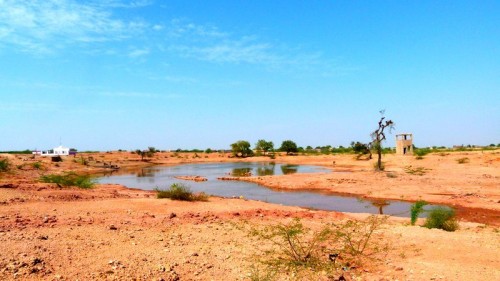
Our tour manager is livid, but the damage is done. The local who had pointed out the site of the cranes says rather mournfully that the cranes would not return for an hour or so or till they felt it was safe for them to do so. Since we do not have the time to wait for the cranes to return, we decided to leave.
It is an angry, diffident and rather shame-faced group that gets back into the bus. Everyone avoids everyone else’s eyes. Our group is also avoiding the angry looks of other tourists who have gathered for crane watching and have now been cheated of it. As for me, I am still to recover from the “now-I-saw-the-Demoiselle-Cranes-and now-I-don’t” tryst I had just experienced. I check my camera to reassure myself that I had indeed seen these birds.
As the bus makes its way out of Khichan to rejoin the highway to take the road to Jaisalmer, I try to recall all that our tour manager had shared about the special guests that Khichan plays host to every winter.
Demoiselle Cranes migrate to Khichan from Eastern Europe. During the months they are at Khichan, the villagers take care of the birds by feeding them grain at specially built enclosures or chugga ghars, and ensuring that they are safe from dogs and other predators. During the time that the cranes are in Khichan, the village also receives bird lovers, ornithologists, and tourists to see the beautiful birds.
At a personal level, this sighting of Demoiselle Cranes has kind of changed my attitude towards birds and bird watching from a polite indifference to a somewhat newly awakened interest. While this does not mean that I am going to get up at an unearthly hour to go birding, it does mean that I am very disappointed at having got just 3 minutes with the cranes and wish that I had got to see more of these graceful birds.
It also means that I am interested in knowing more about the avian world and extend my limited and rudimentary knowledge beyond the world of sparrows, crows, pigeons, parrots (or is it parakeets?). And maybe, just maybe, the next time someone shouts “look, look” or “look at that…” yellow-footed, green-tipped, purple-bellied, orange-collared, blue beaked, red-eyed, white-cheeked birds, black-shouldered… bird, I just might turn around to see them, instead of rolling my eyes.
– Re-posted with permission from Sudha Ganapathi
More Related Stories,
A Floral Paradise: Kolkata’s Indian botanic Garden
Young Naturalists Sights Great Indian Bustard in Karnataka
Home of the Hornbills saved by Defence Radar
Image by Jess.Atkinson via cc/Flickr and Sudha Ganapathi (All Rights Reserved)



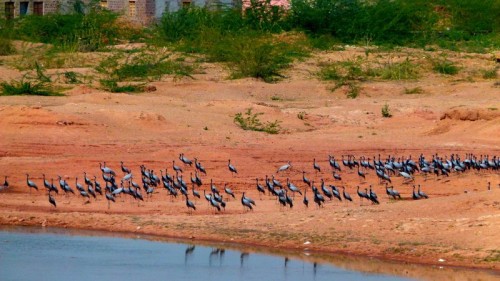

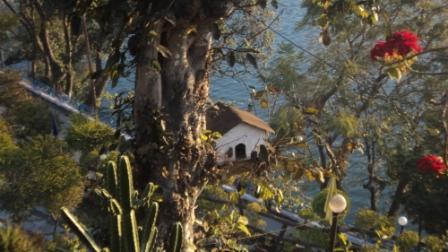
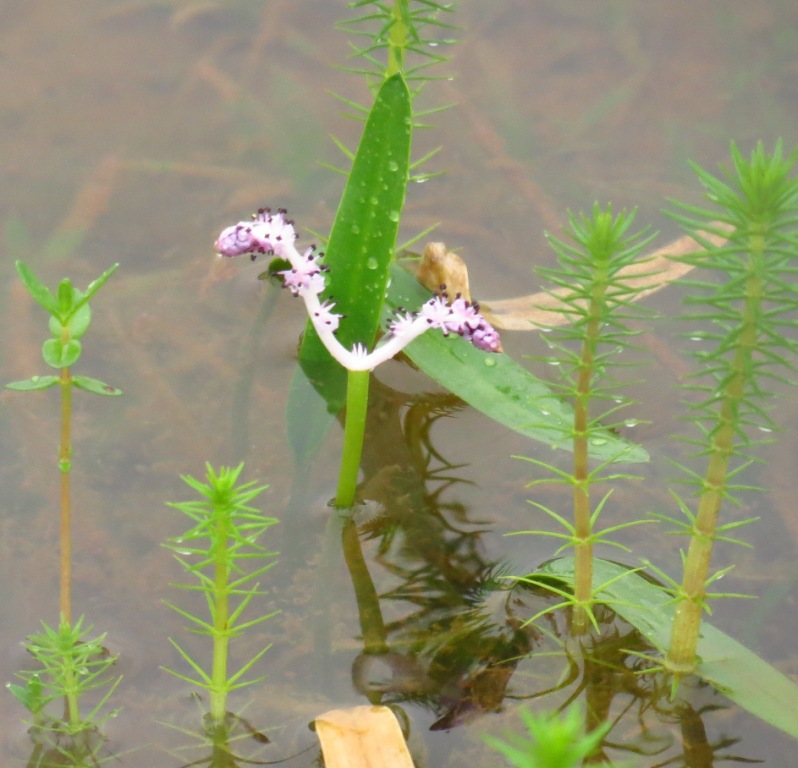
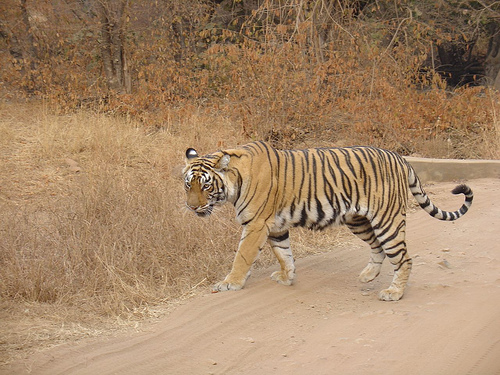
Welcome to the birdwatcher’s club, Sudha I myself too, prefer to stay at the fringes rather than jump right in the middle where all the action is happening. Because in doing so, there is a huge danger of loosing the perspective, just as you have observed in this amusing post. Bird wactching means that we are concerned about the birds and other wild animales and thus should be concerned about THEIR wellbeing. It is quite unfortunate when the bird watching endeavour becomes centered around the BIRDWATCHER’S
I myself too, prefer to stay at the fringes rather than jump right in the middle where all the action is happening. Because in doing so, there is a huge danger of loosing the perspective, just as you have observed in this amusing post. Bird wactching means that we are concerned about the birds and other wild animales and thus should be concerned about THEIR wellbeing. It is quite unfortunate when the bird watching endeavour becomes centered around the BIRDWATCHER’S
“Bird watching means that we are concerned about the birds and other wild animals and thus should be concerned about THEIR wellbeing.”
You have said this so well, and I’m going to say this next time I get caught in a group of militant birdwatchers
Thank you for the welcome, Amrita. Though I think there is a long way to go before I become a full-fledged member of the birdwatcher’s club
Some people have no idea of bird-watching. Thank you Sudha for this post. It will serve as a lesson for those who forget that they are intruding into someone’s personal space when they go over the top watching birds or other wildlife.
As a member of my school’s nature club, I enjoyed going for nature trails that included bird watching. But these days, it’s a different story. Passion for an interest has become almost fanatical and militant like. I’ve seen organised tour groups getting hijacked by such people. And objections would be met with, “You don’t like birds/wildlife/animals? How could you be so heartless?”
And then they go ahead and do stuff like this !
Interesting description – I’ve spent all my growing years in Rajasthan and yet have never heard of this village called Khichan – I’d love to go there – but with a group that follows rules and remains quiet – being an avid birdwatcher, I know how annoying it can get when noisy passerby/children/ or companions play spoilsport. Birds are extremely sensitive to sound and movements – even a camera whirr can cause them fly.
A bird watcher and a fine photographer like you must visit this place. And yes, with a group that respects the basic rules of being one with nature. ..:)
Lovely to see Sudha being featured on this blog
We are an insensitive people in addition to being self-centred. Else why would the tourists have rushed to the birds? To show off to their ‘friends’ on FB the fabulous photos they had taken, of course!
Sudha’s story highlights the ever-increasing ‘nose-poking’ on the rise among so called nature lovers. You have pin-pointed an excellent reason. A major factor is truly the showing off phenomena on FB. Let us hope the story catapults the problem and makes amateurs as well as proffesionals realise the mistake they are commiting.